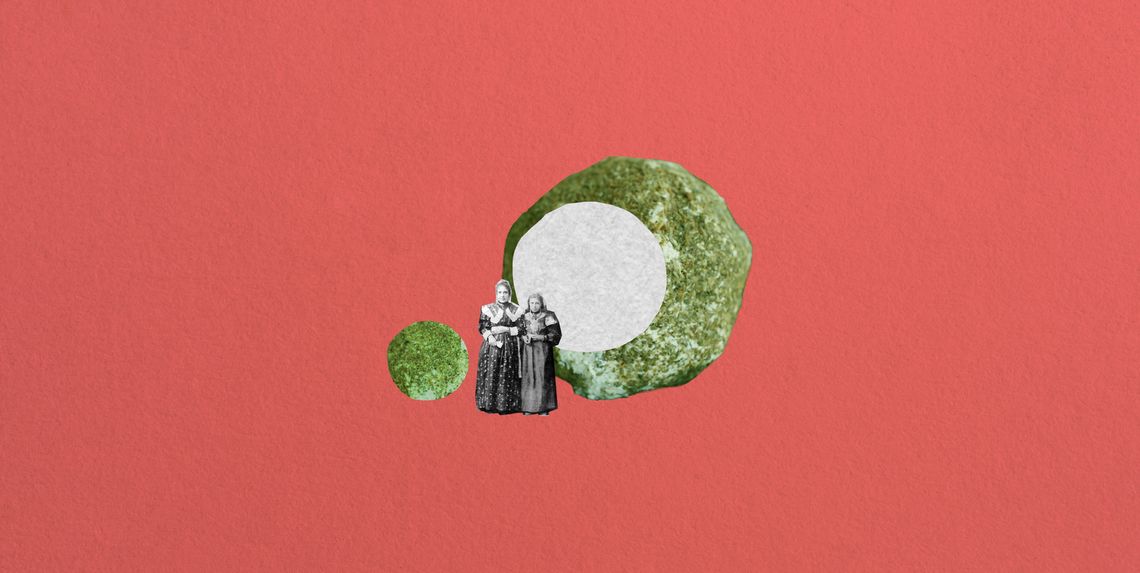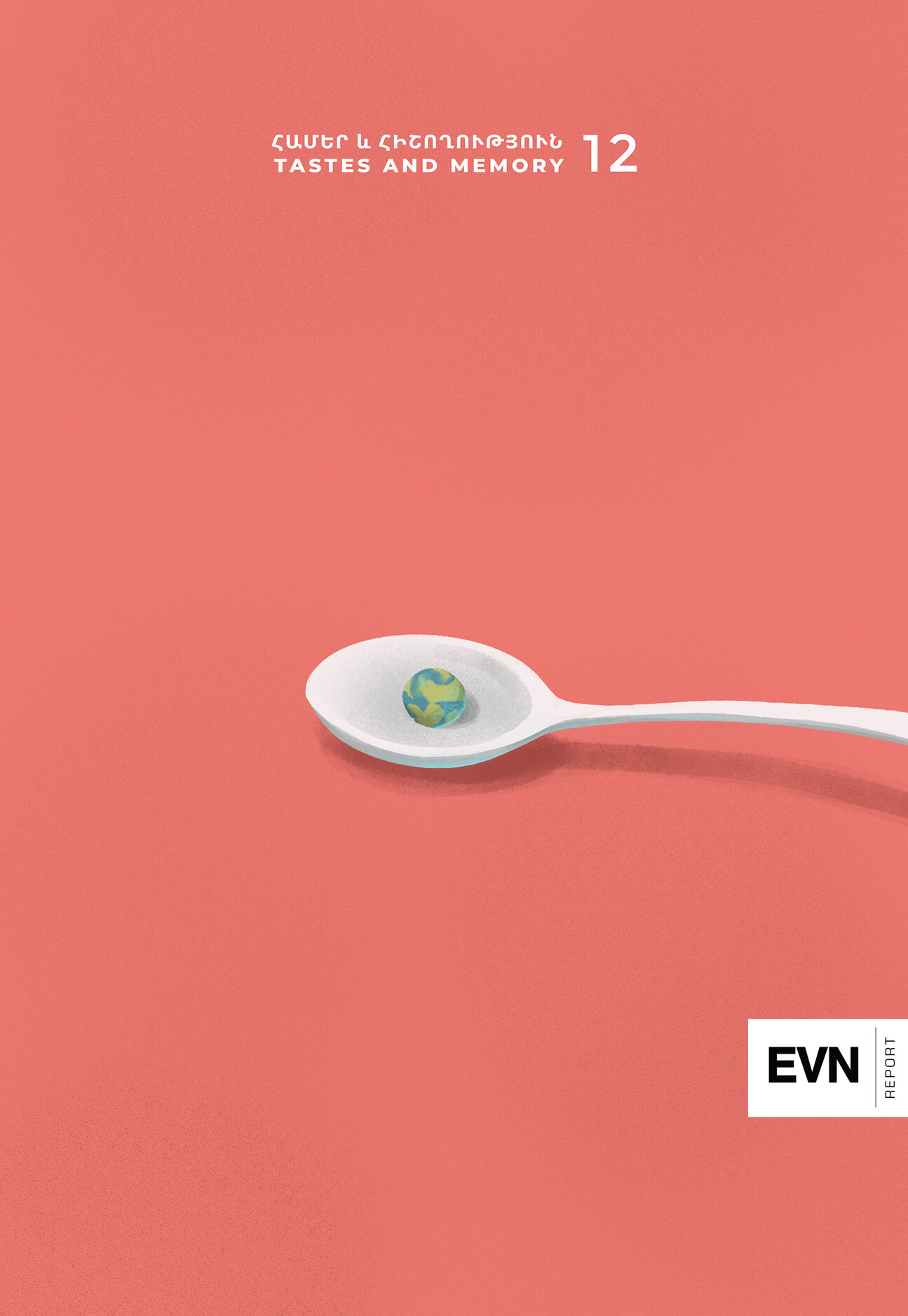

Illustration by Armine Shahbazyan.
When the morning sun streamed in through the window, the flakes of aged cheese floating in the bowl of olive oil would glitter like particles of gold. My father would break off a piece of pita bread, shape it into a small cone and then reverently dip it in the olive oil to scoop up the orange colored cheese. But this wasn’t the kind of cheese you could buy in a supermarket, especially not in Toronto in the 1970s.
I used to believe that only our family made this strangely pungent cheese we knew as sourki. I considered it a divine ancestral link to a time and place that was foreign yet so very familiar to me in a country that would forever be foreign to my parents. It was only later in life that I came to know that sourki was referred to as shinklish or chinglish and it wasn’t uncommon at all. I felt swindled out of a special secret.
Like most recipes, sourki is claimed by many different peoples in the Levant. Some say it is authentically Syrian, others Lebanese. The Egyptians, Palestinians and others have their own versions of it. I was made to believe that it was a traditional dish of Musa Ler, so I’ll stick with that.
But my father’s insistence on the provenance of sourki can be traced back to his own roots and the harrowing continuity of upheaval and rupture. During the First World War, as Ottoman Turkey began the systematic annihilation of the indigenous Armenian population of its empire, the people of Musa Ler organized a self-defense that became the stuff of legends. This resistance was memorialized in Franz Werfel’s 1933 seminal novel “The Forty Days of Musa Dagh”, a book I was instructed to read at a young age, one that occupies a place of privilege in my library and is plaited in the depths of my identity.
After World War I and the collapse of the Ottoman Empire, Musa Ler was transferred to the Sanjak of Alexandretta of the Mandate of Syria. The sanjak was later handed over to Turkey in 1939 and the native Armenian inhabitants of Musa Ler were moved to Ainjar, Lebanon by the French where they continue to live.
It’s a long and convoluted era of the history of my forefathers. Regardless of who claims sourki to be their own, my self-delusional truth is that it originated in Musa Ler, a land of fiercely stubborn, rugged mountain people who lived on the shores of the Mediterranean. With the loss of my father years ago, it’s a delusion I fervently hang on to. Perhaps it’s one that my father needed to hang on to as well.
And while sourki was intrinsically tied to a mystical place, I never liked it. In fact, I never could grasp the charm of drying, aging and letting cheese go moldy. For my father, the moldier it became the better. When he deemed it ready to be eaten, he would wipe off the bluish-blackish mold with a cloth and start carefully slicing it. I can still see him sitting at the kitchen table painstakingly slicing the sourki with a paring knife. As he cut into it, the smell would have us running to the next room. As our palette developed over time, however, sourki soon became a favorite.
The traditional way of preparing sourki is arduous. It begins with preparing homemade yogurt and then placing it in a clay jar or pot. The yogurt is then shaken by hand to allow butter to form at the top which is then skimmed off. The process is repeated until the yogurt breaks down and a white substance is formed on the bottom; this is then heated until it curdles. Next it is strained for several hours until it thickens. Thyme and Aleppo red pepper is added and then the mixture is formed into balls to let dry in the sun. The longer it is aged, the darker and moldier it becomes. By the time the recipe crossed the Atlantic from the Middle East to North America, however, it changed. My ever resourceful mother made sourki with strained cottage cheese bought from the local grocery store, certainly not the way it was meant to be made.
When she and I traveled back to Lebanon and Syria in 1988, she found the original, authentic base for sourki, which smelled like curdled cheese, and tried to bring it back to Toronto with her. A fact she conveniently failed to tell me. At the airport, when we were stopped by customs, they discovered the smelly concoction and my mother in her panic, said, “Throw it out, throw it out!” The customs agent unceremoniously did.
After that incident, she begrudgingly continued to make sourki with strained cottage cheese. She would add the spices, knead it and then shape it into small balls. After placing them on a tray, they would be let out to dry in the sun. In the harsh Canadian winter months we were tasked with making sure to move the tray as the sun’s rays moved across our small apartment to ensure it got as much sunlight as possible. Once dried, it was placed in a large glass jar and stored in the pantry.
But sourki was more than just dried, aged cheese that we ate soaked in oil. Often before the drying process would begin, my mother would add a generous amount of finely chopped onions, pepper paste and olive oil to the wet sourki to prepare the topping for a traditional cheese bread called banderoum hootz (banirov hats) in the dialect of Musa Ler and Kessab, the other ancient Armenian village in Syria. The Kessabtsis often refer to it as kesbou hootz (Kessab bread). In these Armenian villages, banderoum hootz would be baked in a tonir.
Sourki and banderoum hootz were staples in our home. And just as these recipes were brought to Canada in the 1960s from the Middle East, I carried them back with me across the Atlantic when I moved to Armenia some 35 years later. Now, I continue the tradition and several times a year I make them, although I have altered the recipes. These days I make sourki and serve it with chopped tomatoes and onions, the way my Kessabtsi husband’s family did it, a process that my father snubbed his nose at. And when I make banderoum hootz, I don’t use sourki as the base anymore. I grate whatever cheese I have on hand, add a generous amount of chopped onions, thyme, red pepper, salt, black pepper and lots of olive oil. I even learned how to make homemade dough (no small achievement—yeast and I don’t get along). After the dough is ready, I roll it out and add the cheese mixture on top and bake it in the oven. While this might sound sacrilegious to the hard-core banderoum hootz cooks, to be honest, it tastes just as good.
As recipes criss-cross the planet with the flows of migration, they are altered, molded and adapted. They carry not only ingredients but memories of home and family, of history and heritage and places that no longer exist, at least not for us, perhaps not even ever. In the process, we create new memories and new ways of preparing ancestral dishes to be passed on to the next generation. Where they take them and how they modify them will define a future yet to be written.
Tastes and Memory
Magazine Issue N12


Food is a repository of our most cherished memories. It connects us through time and space and memory unlocking the keys to our heritage. It carries us back to our childhood. To large family dinners, of tables overflowing at Christmas, Easter, birthdays. It binds us to the lands that we are no longer the masters of. Recipes carried across cities and deserts and continents, handed down from one generation to another are vessels of a family’s traditions and customs even when they are altered, adapted and molded to new realities. This month’s issue entitled “Tastes and Memory” is not simply about food or recipes, it’s about identity and the stories that are woven into the fabric of our collective memory.

